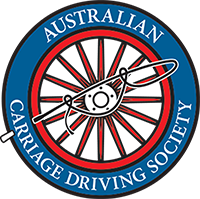Show Driving
Show Driving
Show driving is a captivating equestrian discipline that emphasises the beauty, elegance, and historical significance of horse-drawn carriages. Judges assess the overall turnout, condition, and authenticity of the equipment, the quality of the horses’ movement and the driver’s skill in presenting the carriage.
Carriage driving at Australian shows is often seen in two forms – Light Harness and Heavy Harness.
Light harness classes are those for the lighter-boned breeds of horses and ponies. Animals are generally shown in these classes in vehicles such as viceroys, sulkies, jinkers, gigs, joggers, buggies and other relatively light two and four-wheeled vehicles.
The Heavy Harness classes, often termed the Business and Delivery classes, cater for the heavier draught breeds of horse and various crosses with these. They are often shown in delivery vehicles such as milk and bread carts, spring carts and wagons.
The ACDS runs an annual National Show, which moves around to a different state each year, and annual State Shows. These ‘all harness’ shows have much more extensive programs than most agricultural shows, with a wide variety of classes for the range of horses and ponies and vehicles driven by carriage drivers.
It is essential not to be put off when you realise you do not have all the ‘correct’ gear. If your horse, harness and vehicle are safe, go in the classes. Make sure your horse and turnout are as clean as possible, and have your hat, knee rug or apron, gloves and whip. You could be very pleasantly surprised about how well you do!
Royal Shows are a different story – the overall standard is much higher. However, showing in harness at a Royal is a wonderful thing to aspire to and is well worth the effort.

Attention to Detail
High-level show driving emphasises meticulous attention to detail, from the polished brass and leather harnesses to the driver’s and passengers’ attire. This focus on authenticity and presentation creates a visually stunning display.

Artistry and Craftsmanship
The artistry of the carriages, harnesses, and attire is a central attraction. Spectators can appreciate the intricate detailing, ornate designs, and the skill that went into creating these masterpieces.

Spectacular Turnout
The turnout – the complete presentation of the carriage, harness, horses, and driver – is a captivating aspect of show driving. The harmonious coordination of these elements is both visually striking and artistically impressive

All drivers
All drivers are encouraged to compete in the harness classes at shows whenever possible. Horse-drawn vehicles of all types are great crowd favourites, and showing in harness is one of the best ways to show off our sport to the public
Beauty and elegance in motion
Show Driving events through to the end of 2025 include:
NSW State Show Driving Championships at Gulgong
A variety of Agricultural and Breed Shows in towns and cities across NSW throughout the year
The NSW Branch of the Australian Carriage Driving Society has 18 clubs located throughout NSW.
Once you become a member of an ACDS affiliated club you may participate in the activities of any other affiliated club

